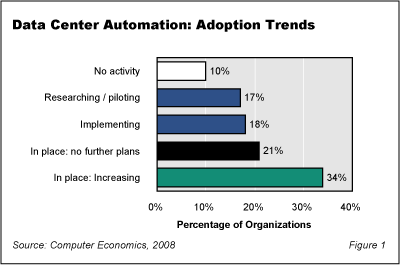Data center automation is a high-priority investment for IT organizations today. Currently, the technology figures into the spending plans of more than half of all U.S.-based organizations, ranking it fifth out of 24 technologies where organizations plan to spend new-initiative dollars this year, according to our annual survey. The allure is double-barreled: automation promises to improve service levels while freeing resources to reinvest in the infrastructure. With the proliferation of low-cost servers, 24/7 operational demands, and data center consolidation, integrated service management automation is becoming a necessity for reining in chaos and a key ingredient for fulfilling the promises of virtualization, service-oriented architecture, and other components of the adaptive, flexible enterprise.
This Research Byte is a summary of our full report, Data Center Automation: Adoption Trends.
DCA technology is a broad category. DCA applications, initially considered just tools for provisioning servers, are evolving into suites that include a variety of modules for everything from IT process automation, to asset discovery, configuration management, and change management. Today’s suites must cut across data center silos, bringing server administration, application maintenance, and storage management into the integrated service management fold. With the growth in server and storage virtualization, automation software also must be able to maintain physical, virtual, and logical resources. Hewlett-Packard’s acquisition of Opsware in July 2007 and BMC’s BladeLogic purchase in April put them among the leaders in offering comprehensive products. IBM, CA, and Novell are also in the hunt, while a variety of point-solution vendors excel at specific tasks.
Trend Indicates Adoption Level Is High
Enterprises are investing widely in data center automation, as they are in labor-saving automation tools of all types. In fact, our annual survey of 200 IT organizations of all sizes and sectors rates the adoption level as “very high.” This is illustrated by the sharp, stair-step appearance of the descending bars in Figure 1, which increase at each adoption stage.
Figure 1 shows that 34% of our respondents have DCA tools in place and are increasing their investments in the technology. Another 21% have DCA in place but do not plan to add to their installations. Implementation is in progress at 18% of the organizations. Participants are researching or piloting DCA in 17% of the cases. Only 10% of the IT managers queried state that they have no activity underway.

In the full version of this report, we assess the overall adoption trend, the percentage of companies that have deployed the technology, and the current level of investment activity. The study also investigates how organizational size affects adoption trends and investment activity. A final look at how investment activity differs by industry sector completes the statistical picture. We conclude with recommendations for measuring return on investment and scoping data center automation projects, as well as considerations for selecting solutions.
Data center automation can improve data center performance and simplify the work of the data center manager. In order to realize these benefits, the DCA project team must choose the right solution and focus the effort on those areas where there is the greatest payback. Even the best DCA products are only effective if skilled staff members, guided by capable management, employ them.
This Research Byte is a brief overview of our report on this subject, Data Center Automation: Adoption Trends. The full report is available at no charge for Computer Economics clients, or it may be purchased by non-clients directly from our website at https://avasant.com/report/data-center-automation-adoption-trends-2008/ (click for pricing).

